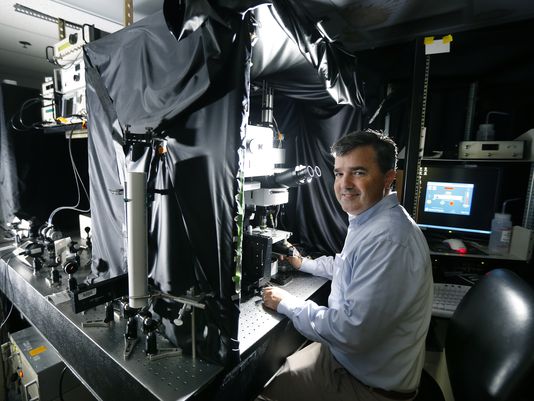Edward Brown Uses Self-Made Laser Microscope for Breast Cancer Research
 Edward Brown's research is a mixture of photonics, microscopes and a little nudge from his mom.
Edward Brown's research is a mixture of photonics, microscopes and a little nudge from his mom.
Brown, who teaches biomedical engineering at the University of Rochester Medical Center, has built a laser-and-microscope device to study how likely cancer cells will spread throughout the body. Specifically, he's looking at how likely cancer cells have spread inside breast cancer patients who already have had the tumor removed.
Learning more about the cell movement, called metastasis, is key to a larger overtreatment problem that Brown is trying to fix.
When patients first realize they have breast cancer, it's unclear whether the cancer cells have spread, so doctors recommend chemotherapy as a precaution. However, Brown and other medical researchers believe patients are being overtreated because doctors are giving chemo to patients who may not need it.
"It's impossible to tell for sure whether that patient is going to get metastasis, so they're more likely to overtreat and give them chemo to avoid possible metastasis," Brown said.
If possible, breast cancer patients should avoid chemo, Brown said, because the procedure is "just poisons that go throughout the body that hopefully kill the tumor cells a little faster than they kill you."
Brown's device sits on a platform slightly longer than a ping-pong table. He turns on the laser and it emits a red light beam that bounces off six mirrors, then goes through four other devices that adjust the light beam's intensity and finally ends up inside the microscope. Using the device, Brown and his two graduate students are looking deep inside tumor tissue.
When Brown looks inside the microscope, he's looking at proteins and fibers immediately outside a collection of cancer cells — "the scaffolding that the cells live on." Brown believes there's a connection between how the scaffolding is made and the likelihood that cells will move. Brown can see these cells because he's using red light, which is a lower-powered light than the white light used in most microscopes.
Other researchers across the country are looking at cancer cell movement. Brown plans to publish his findings so other researchers can use them.
Brown said his research is less than five years away from being used by practicing doctors, but ultimately, if successful, his findings would allow doctors to "do patient-tailored therapy."
"We can help suggest to the patients who are more likely to experience metastasis that you should probably go into the chemo arm," he said. "Patients who are less likely to experience metastasis, you might not need the chemo."
Although he's unique by focusing on breast cancer, Brown is one of many researchers trying to find the latest breakthrough in photonics for medical purposes.
Dennis Matthews, a recently retired neurological surgery professor at the University of California, Davis, is an expert on optically based biosensors and medical devices. Matthews said photonics is still a young area of study, and the intersection of photonics and medicine is one of the major areas that researchers are studying. He mentioned an online community called Photonics 4 Life, where thought leaders share results.
There's a push nationally, Matthews said, because there are dozens of diseases that doctors can't spot early enough. Medical devices that use photonics might be able to help.
Another problem in medicine that photonics might be able to help: being able to see how the diseases react to drug treatment inside the body in real time, Matthews said.
With cancer specifically, Matthews said the goal would be to "use light to identify in a living person the presence of a (cancer) tumor."
"And if we can diagnose skin cancer earlier, that'd be great," he added.
Monroe County has some of the highest number of breast cancer cases in New York state, according to data from the state health department. Between 2008 and 2012, there was a reported annual average of 646 female breast cancer cases in Monroe County.Nearby Ontario County had an annual average 91 cases between 2008 and 2012.
There were more than 125 reported deaths caused by female breast cancer in Monroe and Ontario counties during that same time period. The department does not keep similar data for Monroe County men.
Brown is doing research on a disease that mostly affects women, so it's fitting that a woman steered him toward this field.
In 2004, his mother found an advertisement on a bulletin board from the U.S. Department of Defense asking for scientists who wanted money to research overtreatment of breast cancer patients. The $2.4 million grant would fund someone's research for the next five years and ultimately steer their career into breast cancer expertise. At his mother's urging, Brown gathered his materials, sent them in and waited.
"I remember submitting it and thinking 'I don't care if it's just for a dollar as long as I get it so I can tell my mom that I got it,'" Brown said. "So I did and I got it."
This article was republished from the Democrat & Chronicle. Read the full story here.
